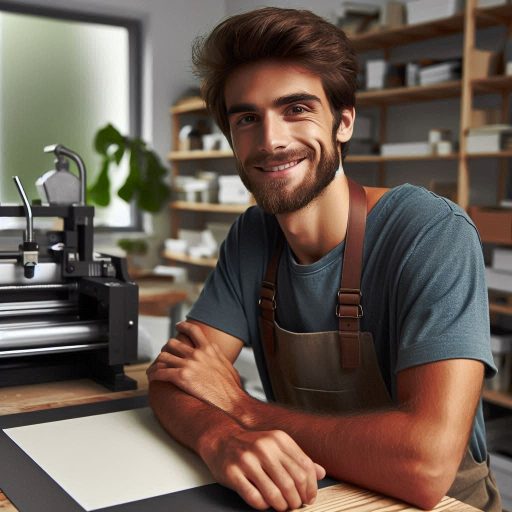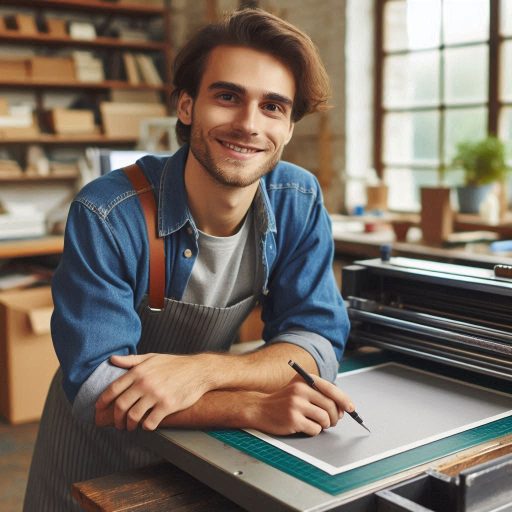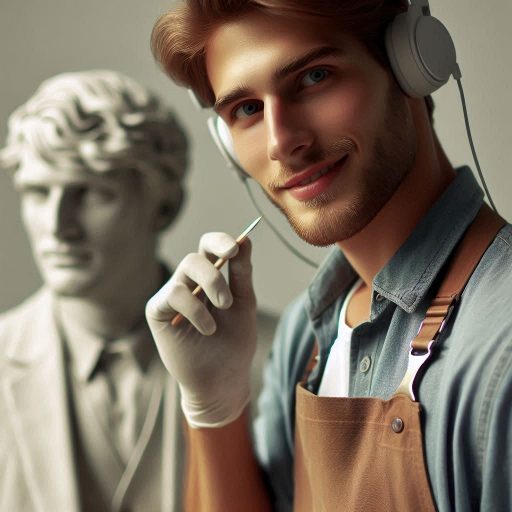Introduction
Sculptors have played a crucial role in the world of art for centuries, shaping visual culture and influencing societal views.
From ancient civilizations to the Renaissance period, sculptors have been revered for their ability to transform raw materials into powerful forms of expression.
In contemporary art, sculptors continue to push boundaries and redefine what it means to create three-dimensional works of art.
Their work is not only about creating aesthetically pleasing pieces but also about challenging perspectives and sparking conversations.
This blog post aims to delve into the changing role of sculptors in the modern art world, exploring how they navigate through a rapidly evolving landscape of art practices, technology, and social issues.
We will examine the ways in which sculptors adapt to these changes and continue to make a significant impact on the art scene.
Definition of Contemporary Art
Contemporary art encompasses artistic work produced today, reflecting current ideas and technologies.
Unlike traditional art, which often adheres to established techniques and styles, contemporary art is fluid and experimental.
Contemporary Art and Its Differences from Traditional Art Forms
Contemporary art refers to art made in the present era, often characterized by a departure from traditional styles.
Traditional art typically follows established rules and methods, while contemporary art embraces innovation and diversity.
Traditional forms often focus on classical techniques and themes, whereas contemporary art challenges norms and explores new media.
This approach allows for a broader range of expression and reflection of modern society.
Characteristics and Themes Commonly Explored in Contemporary Art
Contemporary art is diverse and often defies easy categorization.
It includes abstract, conceptual, and multimedia works, reflecting a wide array of themes.
Artists might explore identity, globalization, and technology.
Themes of social justice, environmental issues, and personal introspection frequently appear.
The art can be provocative, aiming to engage viewers in critical dialogue and self-reflection.
These characteristics distinguish contemporary art from its predecessors, emphasizing innovation and relevance.
Importance of Sculptors in Creating Contemporary Artwork
Sculptors play a crucial role in contemporary art by pushing the boundaries of three-dimensional work.
They experiment with unconventional materials and techniques, contributing to the evolution of modern sculpture.
Transform Your Career Today
Unlock a personalized career strategy that drives real results. Get tailored advice and a roadmap designed just for you.
Start NowSculptors challenge traditional notions of form and space, creating pieces that engage viewers in new ways.
Their work often incorporates aspects of installation and interactive art, expanding the possibilities of sculptural practice.
Sculptors‘ contributions are vital in shaping the landscape of contemporary art, enriching the art world with fresh perspectives and innovative forms.
In summary, contemporary art represents the dynamic and evolving nature of modern artistic expression.
Sculptors are essential in this realm, continually redefining and expanding the boundaries of art.
Read: How to Start a Successful Sculpture Business
Evolution of Sculptors in Art
Sculpture has been an integral part of art history, dating back to ancient civilizations.
Throughout the years, sculptors have played a crucial role in art movements, shaping the course of artistic expression.
Key sculptors such as Michelangelo, Rodin, and Brancusi have made significant contributions to the field with their innovative techniques and artistic vision.
Michelangelo’s masterpiece, the statue of David, showcases his exceptional skill in marble carving and anatomical precision.
Rodin’s expressive sculptures, such as “The Thinker” and “The Kiss,” revolutionized the art world with their emotional depth and realism.
Brancusi, known for his abstract approach to sculpture, explored the essence of forms through his simplified and streamlined works.
Adaptation to Changing Trends and Technologies
Over time, sculptors have adapted to changing trends and technologies in art, incorporating new materials and techniques into their practice.
The advent of 3D printing has revolutionized the way sculptors create and manipulate forms, allowing for more precise and complex designs.
Contemporary sculptors like Anish Kapoor and Jeff Koons have embraced technology in their work, exploring the boundaries of traditional sculpture with innovative methods.
Kapoor’s monumental installations, such as “Cloud Gate” in Chicago, demonstrate the fusion of art and technology in large-scale sculptures.
Koons, known for his sculptures of everyday objects, blurs the line between high and low art, challenging conventional notions of beauty and value.
As technology continues to advance, sculptors are pushing the boundaries of the medium, experimenting with new materials like plastics, metals, and found objects.
The role of sculptors in contemporary art is evolving, as they navigate the intersection of tradition and innovation, creating new forms of expression for the modern world.
Read: Printmaking: From Concept to Final Piece
Transform Your Career Today
Unlock a personalized career strategy that drives real results. Get tailored advice and a roadmap designed just for you.
Start NowTechniques and Materials Used by Contemporary Sculptors
The various techniques and materials used by sculptors in creating modern artwork
Contemporary sculptors use a diverse range of techniques and materials to create modern artwork.
Traditional materials like marble and bronze remain popular, but many artists now explore unconventional options.
These include recycled materials, plastics, and resins.
One technique gaining prominence is mixed media, which combines various materials into a single piece.
Artists also employ 3D printing to create complex forms that were previously impossible to achieve.
This technology allows for rapid prototyping and intricate detailing.
Innovative approaches and tools that have revolutionized sculpting processes
Innovative approaches have significantly changed sculpting processes.
Digital tools like computer-aided design (CAD) software help sculptors visualize their creations before physical production.
Laser cutting and CNC machines enable precise cutting and shaping of materials, enhancing both accuracy and efficiency.
These tools have made it easier to execute intricate designs and produce consistent results.
The impact of new technologies on the work of contemporary sculptors
The impact of new technologies on contemporary sculpting is profound.
Virtual reality (VR) allows sculptors to experiment with scale and spatial relationships in a digital environment.
This exploration helps in refining their vision before committing to physical work.
Additionally, augmented reality (AR) can be used to project potential sculptures into real-world settings, offering new perspectives on how the final piece will interact with its surroundings.
In short, contemporary sculptors benefit from an expanded toolkit of materials and techniques.
The integration of digital tools and new technologies continues to push the boundaries of traditional sculpting.
These advancements not only enhance artistic expression but also revolutionize how sculptors approach their craft.
As the field evolves, it opens up exciting possibilities for future artworks.
Read: Sculpture Techniques: From Traditional to Modern

Themes and Concepts Explored in Contemporary Sculpture
Common themes and concepts that contemporary sculptors address in their work
Contemporary sculptors are constantly exploring new themes and concepts in their work, pushing the boundaries of traditional sculpture.
Transform Your Career Today
Unlock a personalized career strategy that drives real results. Get tailored advice and a roadmap designed just for you.
Start NowThey address a wide range of topics that reflect the complexities of our modern world and provoke thought and discussion among viewers.
One common theme among contemporary sculptors is the exploration of identity.
Many artists use their sculptures to delve into personal stories and experiences, creating pieces that reflect and represent who they are as individuals.
This introspective approach allows for a deeper connection between the artist and the viewer, inviting them to reflect on their own identities and experiences.
How sculptors use their art to comment on social, political, and cultural issues
Memory is another prevalent theme in contemporary sculpture.
Artists often draw on personal or collective memories to create works that evoke nostalgia, sentimentality, or even trauma.
By tapping into these emotional reservoirs, sculptors are able to create pieces that resonate with viewers on a visceral level, eliciting strong emotional responses and fostering a sense of shared experience.
The diverse range of styles and subject matters found in contemporary sculpture
Nature is also a recurring motif in contemporary sculpture.
Many artists are concerned with environmental issues and use their art as a means of commenting on the degradation of the natural world.
Through their sculptures, they raise awareness of the urgent need for conservation and preservation, challenging viewers to reconsider their relationship with the environment and take action to protect it.
Another important aspect of contemporary sculpture is its role in critiquing social, political, and cultural issues.
Sculptors often use their art as a platform for addressing pressing global concerns, such as consumerism, globalization, and social inequality.
By exploring these themes in their work, artists aim to provoke thought and inspire change, urging viewers to confront the realities of the world around them and consider alternative perspectives.
The diverse range of styles and subject matters found in contemporary sculpture is a testament to the creative freedom and innovation of today’s artists.
From minimalist geometric forms to intricate figurative sculptures, the possibilities are endless.
Some artists choose to work with traditional materials such as marble or bronze, while others experiment with unconventional materials like found objects or recycled materials.
Subject matters in contemporary sculpture are equally varied, encompassing everything from personal narratives to abstract concepts.
Artists draw inspiration from a wide array of sources, including literature, history, science, and popular culture.
Each sculpture tells a unique story, inviting viewers to interpret and engage with the artwork in their own way.
In a nutshell, contemporary sculptors play a vital role in shaping the cultural landscape of our times.
Transform Your Career Today
Unlock a personalized career strategy that drives real results. Get tailored advice and a roadmap designed just for you.
Start NowBy exploring diverse themes and concepts, critiquing social and political issues, and experimenting with a wide range of styles and subject matters, they challenge conventional notions of sculpture and push the boundaries of artistic expression.
Through their creativity and innovation, sculptors continue to inspire and provoke, inviting viewers to think critically and engage with the world in new and exciting ways.
Read: Understanding Printmaking Editions and Proofs
Collaboration and Interdisciplinary Practices
How sculptors collaborate with other artists and professionals in the creation of art installations
In contemporary art, sculptors frequently collaborate with other artists and professionals to create dynamic installations.
This collaboration often involves architects, engineers, and technologists, blending various expertise to push creative boundaries.
For instance, a sculptor might work with an architect to integrate a sculpture seamlessly into a building’s design.
Engineers might help to ensure that large-scale installations are structurally sound and safe.
The rise of interdisciplinary practices in contemporary sculpture, such as mixing sculpture with performance art or digital media
The rise of interdisciplinary practices is reshaping contemporary sculpture.
Sculptors now frequently mix traditional techniques with performance art, creating multi-sensory experiences.
They may incorporate live performances into their installations, where the sculpture interacts with the performers or responds to their movements.
Digital media also plays a crucial role, as sculptors use projections and interactive technology to enhance their works.
This fusion of disciplines creates more engaging and innovative art forms.
The importance of collaboration in pushing the boundaries of traditional sculpting practices
Collaboration is essential in pushing the boundaries of traditional sculpting practices.
By working with professionals from various fields, sculptors can explore new materials and techniques.
For example, combining sculpture with digital media allows for interactive and evolving art experiences that challenge conventional perceptions.
This collaborative approach enables artists to experiment with new forms and concepts, leading to groundbreaking artistic achievements.
Overall, the intersection of sculpture with other art forms and technologies enriches the art world.
It expands the possibilities for artistic expression and engages audiences in new ways.
Through collaboration and interdisciplinary practices, sculptors continue to redefine and expand the scope of contemporary art.
The Role of Sculptors in Society
Transform Your Career Today
Unlock a personalized career strategy that drives real results. Get tailored advice and a roadmap designed just for you.
Start NowHow sculptors contribute to the cultural landscape and public spaces through their artwork
The impact of public art installations created by sculptors on communities
How sculptors engage with audiences and provoke thought through their sculptur
Overall, the role of sculptors in society is multifaceted and essential to the cultural and social fabric of a community.
See Related Content: Must-Read Books for Game Design Enthusiasts
The Role of Sculptors in Society
How sculptors contribute to the cultural landscape and public spaces through their artwork
Public art, especially sculptures, plays a vital role in shaping the cultural landscape and public spaces of a society.
Sculptors have the unique ability to capture the essence of a community and reflect its values and beliefs through their artwork.
By creating sculptures that are displayed in public spaces, sculptors not only beautify the environment but also contribute to the cultural identity of a place.
Impact of public art installations created by sculptors on communities
Public art installations created by sculptors have the power to transform a dull or forgotten space into a vibrant and engaging one.
These installations serve as visual anchors that draw people to a particular area, creating a sense of community and pride among residents.
Sculptures in public spaces also act as landmarks, helping to define the identity of a neighborhood or city.
How sculptors engage with audiences and provoke thought through their sculptures
Sculptors play a crucial role in engaging with audiences and provoking thought through their sculptures.
By creating pieces that challenge conventional thinking or evoke strong emotions, sculptors encourage viewers to reflect on important social issues or contemplate the human experience.
Sculptures have the power to spark conversations and inspire change, making them a valuable tool for social commentary and activism.
Overall, the role of sculptors in society is multifaceted and essential to the cultural and social fabric of a community.
Through their artwork, sculptors contribute to the beauty and identity of public spaces, create meaningful connections with audiences, and provoke thought and discourse on important issues.
Sculptors are not just artists; they are cultural ambassadors who help shape and enrich our society.
Conclusion
Sculptors play a vital role in contemporary art by pushing boundaries and challenging traditional norms.
They bring a unique perspective to the art world, influencing cultural trends and shaping the way we perceive the world around us.
By introducing new mediums, techniques, and concepts, sculptors encourage viewers to think differently and engage with art on a deeper level.
Transform Your Career Today
Unlock a personalized career strategy that drives real results. Get tailored advice and a roadmap designed just for you.
Start NowTheir work sparks conversations, evokes emotions, and prompts us to question our own beliefs and values.
It is essential for art enthusiasts to explore the diverse range of artwork created by contemporary sculptors.
By supporting these artists and engaging with their creations, we contribute to the growth and evolution of the art world
Ultimately, sculptors have the power to inspire, provoke, and transform society through their innovative and thought-provoking creations.
Their impact on the art world is profound and will continue to shape cultural landscapes for generations to come.
So, I encourage you to seek out the work of contemporary sculptors, immerse yourself in their art, and discover the beauty and complexity that they bring to the world of art.
[E-Books for Sale]
The Big Book of 500 High-Paying Jobs in America: Unlock Your Earning Potential
$19.99 • 500 High-Paying Jobs • 330 pages
Explore 500 high-paying jobs in America and learn how to boost your career, earn more, and achieve success!
See All 500 High-Paying Jobs of this E-Book
1001 Professions Without a Degree: High-Paying American Jobs You Can Start Now
$19.99 • 1001 Professions Without a Degree • 174 pages
Discover 1001 high-paying jobs without a degree! Unlock career tips, skills, and success strategies for just $19.99!




